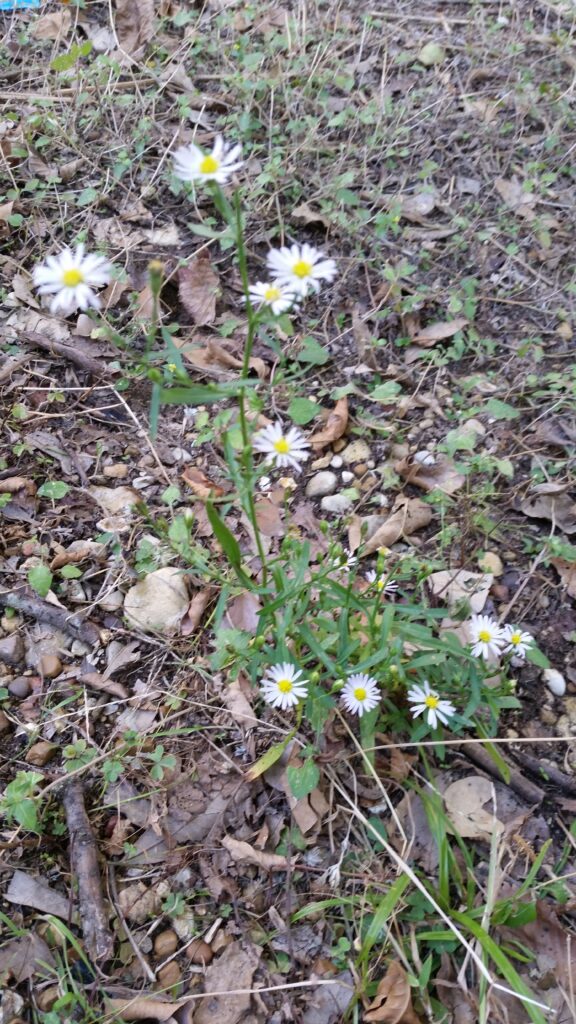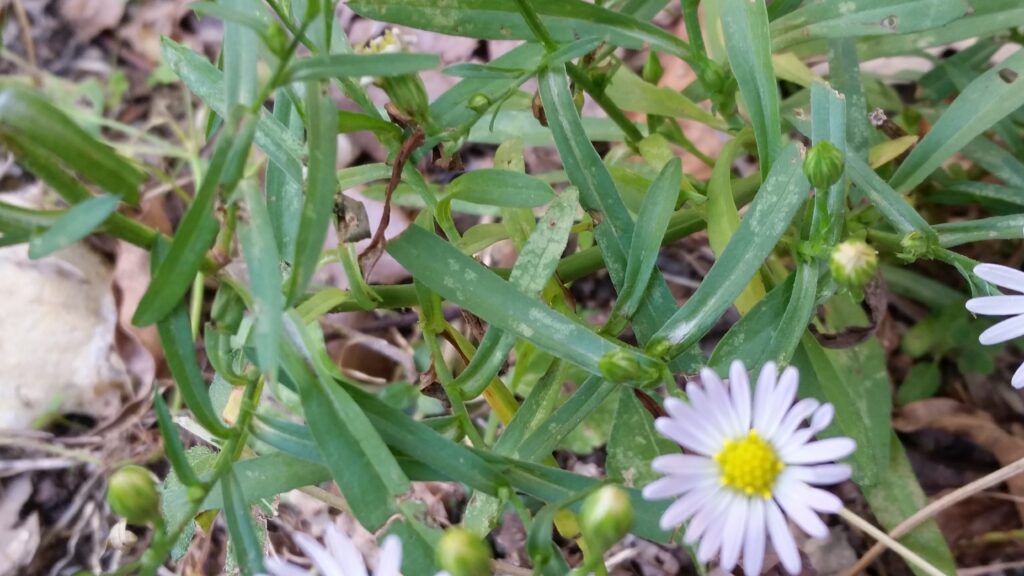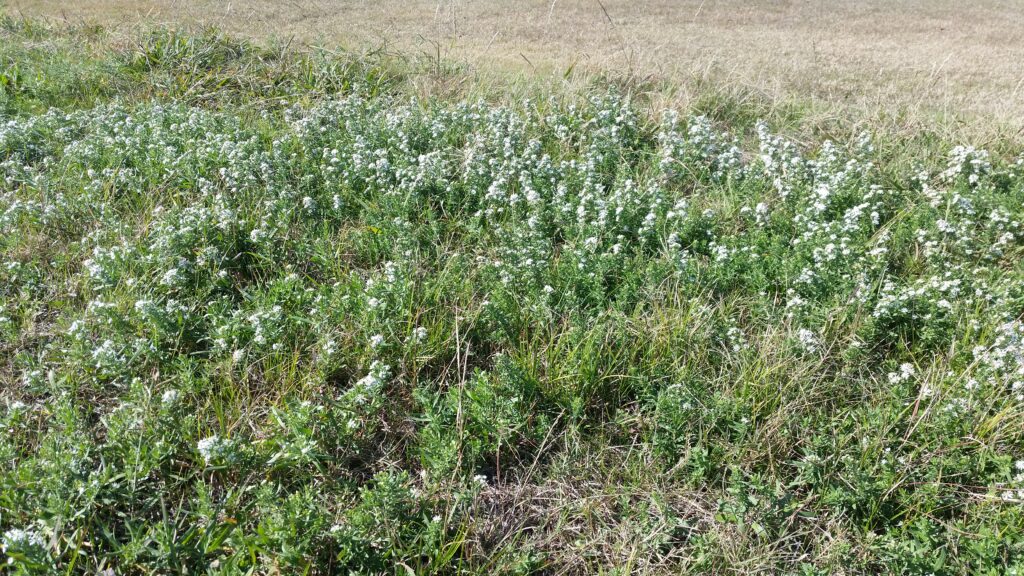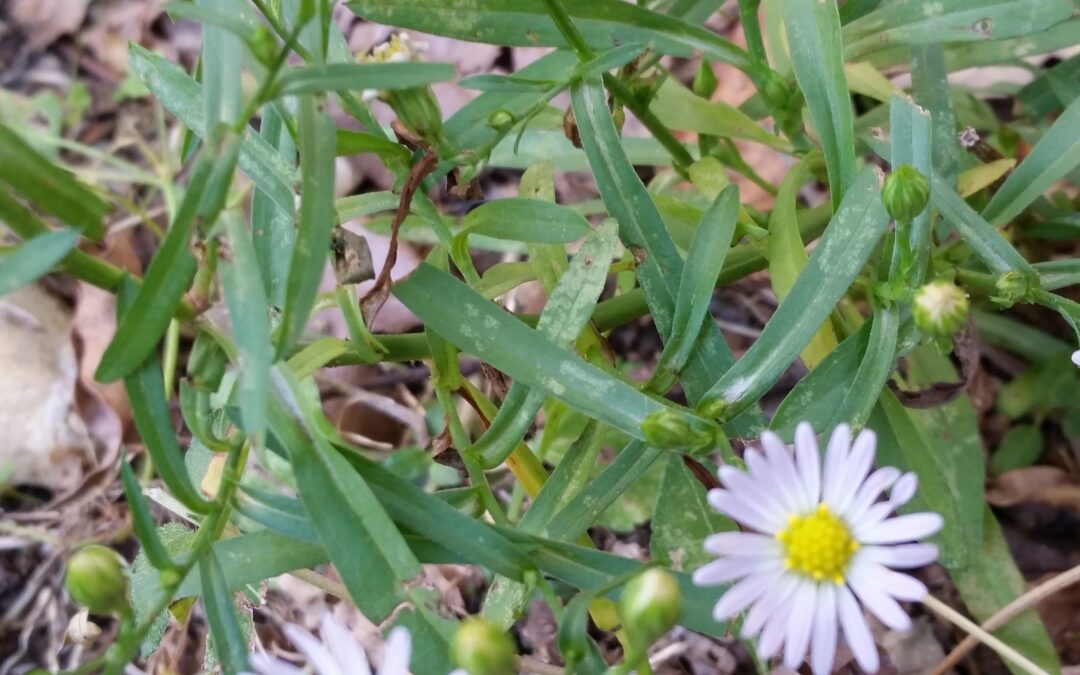In this ‘Weekly Native’ series, I’ll showcase a species of plant that is seasonally active in North Texas. This week’s native is Aromatic Aster, also known taxonomically as Symphyotrichum oblongifolium.
Walking through the rocky side of my yard last week, I found this!

I knew it was in the aster family due to its characteristic flowers. They look a bit like a daisy, but the petals are thinner. They vary in color from white to lavender, and are so small – only a few centimeters wide. The leaves are variable from base to tip. It’s this that made it difficult for me to confirm identification. However, I found there is only one aster that grows here in North Texas. Commonly known as Aromatic Aster, Fall Aster, or by its Latin name, Symphyotrichum oblongifolium, and it is covering the Blackland Prairie right now.
After this sighting at my house, I noticed more of these Asters around on walks in my neighborhood. What struck me most is how many different forms the plant can take. Note the clustered nature of this patch I found in a nearby yard:

The leaves are barely visible among crowded blades of St Augustine grass. What is always striking is the flowers. I wasn’t the only one who noticed them, either. Social media posts in various gardening pages were full of questions about what to do with this perennial that emerged in a yard. Is it a weed? Is it invasive? How can I get rid of it?
That last question was my least favorite, of course, knowing what I know now about this native. From basic observation (see the photos in this post), it’s obvious the plant thrives in many different environments: rocky, disturbed areas; lush and regularly watered yards full of non-native grasses; and of course, my favorite find – on the nearby prairie.

So, what’s so great about Aromatic Aster? Well, a lot, actually. Not only do pollinators love it, but it is drought resistant. So, when social media threads have bits of advice that include pulling up the plant by its root, I have to jump in and say, wait! Think of the bees and butterflies that depend on nearby stops to survive. Know that if you decide to reduce the amount of water you apply to your non-native grass-filled yard it will carry out its growing season regardless. As will many others. But that’s a topic for another post.
In my research, I learned that not only does this plant survive drought, but it works to restore disturbed prairie land. Even though it has a relatively short growing season (from September to early November), it stores its energy in bud banks that exist below the prairie surface. So, pulling it up by the root will do little to prevent it from coming back next year. Furthermore, the more the soil it lives in is disturbed, the more likely it will step in to do some cleanup. Pulling it up by the root will actually promote growth rather than reduce it. The Aromatic Aster is a stabilizer for the prairie, and an essential for maintaining a thriving and healthy ecosystem. Due to many factors, the prairie is at risk, and allowing it to do what it would do without human intervention only bolsters its ability to self-regulate.
That feedback loop is so exciting to me: the prairie gets burned by wildfire, cut down by lawn mowers and heavy foot-traffic, and the easy-going, adaptable, drought-loving Aster steps in to restore and re balance what is off-kilter. What’s even more interesting is that this particular species of Aster has been used medicinally to treat fever. A fever is a kind of imbalance in the body, eh?
This great balancing ability has more mileage when we look at what effect the Asteraceae genus has had on the plant taxonomy community. In the past few decades there has been a lot of debate on whether or not certain plants that were scientifically categorized in the genus actually belonged there. This caused a schism from one genus (Asteraceae) into eight different genera. Even further divisions are currently in discussion. In a way this plant has convinced those of us who notice it to refocus, reclassify, and restore literally and figuratively. So if you notice these growing in your yard, please don’t remove them. They’re there to get in, do some dirty work, and retreat back into the dark below the prairie surface to rise again next fall.
If you’d like to grow Aromatic Aster in your garden, you can divide the plant easily now as it’s growing and bring it in for winter. Or you can purchase it from a local nursery that sells Texas perennials next fall. Whatever the case, do not disturb lest ye be overrun with Aster next year!
References:
Cobb, Forrest, and Roel Lopez. “Facing urban water challenges with integrative irrigation techniques in drought-prone areas.”
Gök, Rengin, et al. “Shear wave splitting and mantle flow beneath LA RISTRA.” Geophysical Research Letters 30.12 (2003).
VanderWeide, Benjamin L., David C. Hartnett, and Daniel L. Carter. “Belowground bud banks of tallgrass prairie are insensitive to multi‐year, growing‐season drought.” Ecosphere 5.8 (2014): 1-17.
Yatskievych, George. “How faster to master the Aster disaster: a primer on the changing nomenclature of Missouri Asters.” (2004): 26-32.

Hi Sarah, I enjoyed your posts this week especially this piece on the Aster. Keep up the good work! Love, KK
Thank you so much for reading, KK! Much love. 🙂